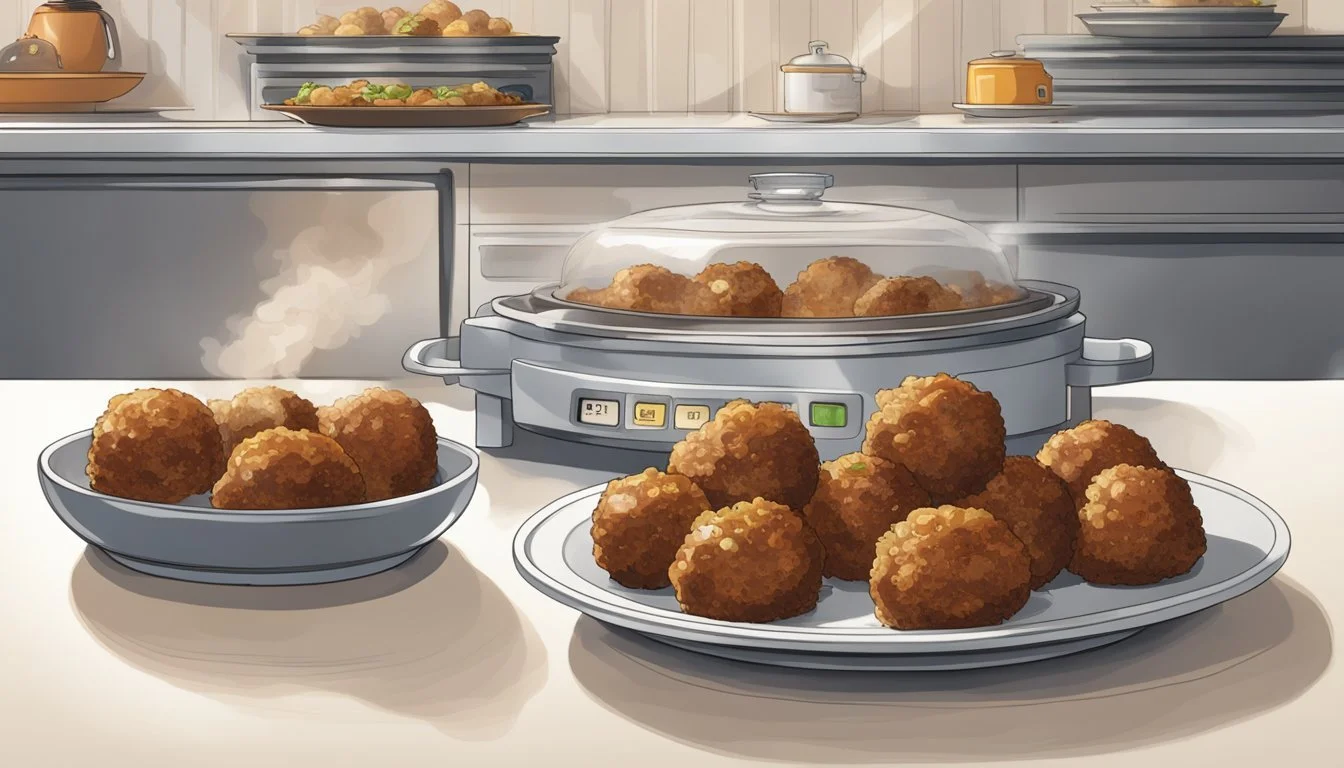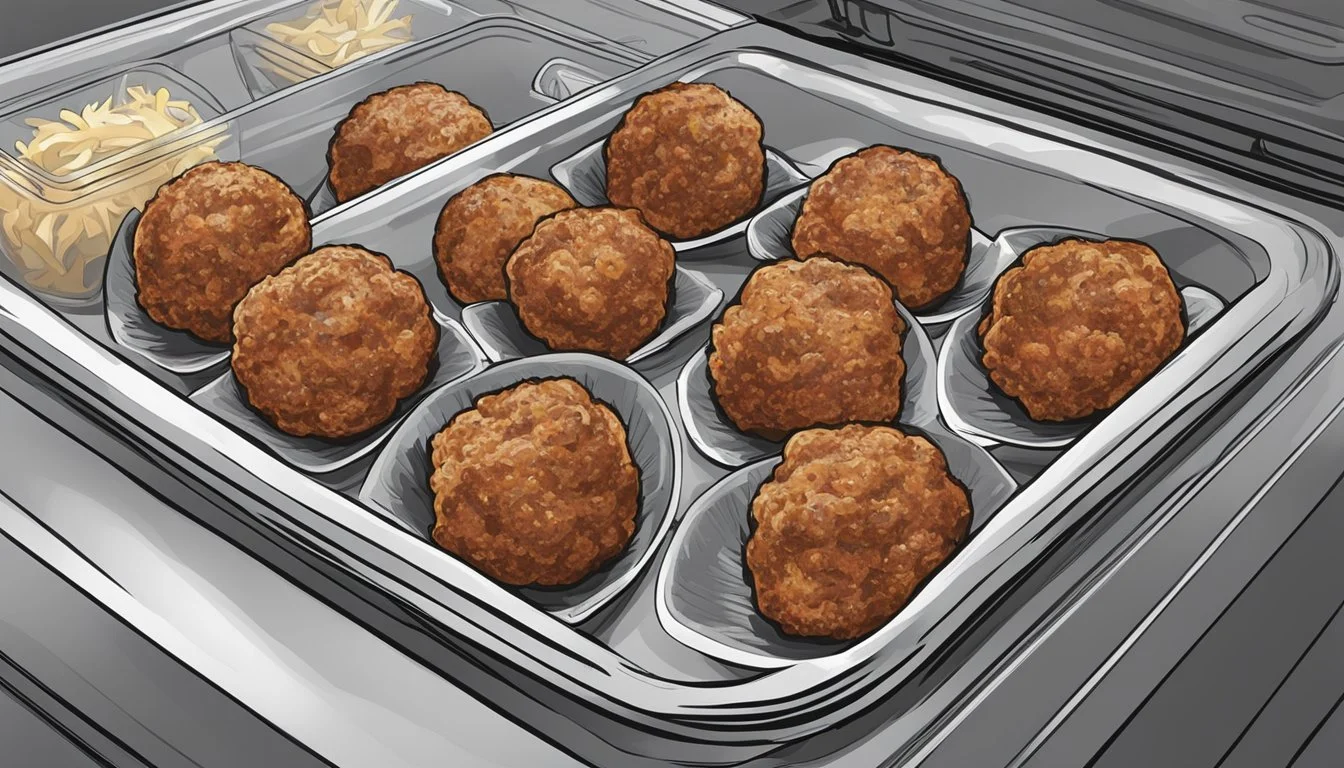How Long Do Freshly Prepared Meatballs Last?
Shelf Life and Storage Tips
When it comes to food storage, one of the common questions that arises in kitchens everywhere is, "How long do freshly prepared meatballs last?" The shelf life of cooked meatballs, when stored properly, typically ranges from 3 to 4 days in the refrigerator. The longevity of these savory spheres is crucial for both food safety and quality, and understanding the proper methods to store them can make all the difference.
Refrigerator temperature plays a significant role in preserving the freshness and safety of cooked meatballs. They should be placed in shallow airtight containers or wrapped tightly with heavy-duty aluminum foil or plastic wrap to maximize their shelf life. Positioned in the coldest part of the refrigerator, usually the back of the bottom shelf, the chilled environment helps to slow the growth of bacteria.
For those who prepare meatballs in larger quantities or wish to keep them for extended periods, freezing offers an excellent option. Frozen meatballs maintain their quality for 2-3 months if properly stored in airtight containers or heavy-duty freezer bags. The process of freezing requires spreading the meatballs in a single layer on a baking sheet until solid, then transferring them to the chosen storage container to prevent them from sticking together. Thawing then can be done in the refrigerator when ready to be used.
Understanding Meatball Preservation
The longevity of meatballs, whether they are freshly prepared or cooked, hinges on various factors. This section outlines the key considerations for preserving meatballs effectively, discerning spoilage, and ensuring safe storage.
Factors Influencing Shelf Life
Shelf Life of Meatballs: Freshly prepared meatballs have a shorter shelf life, lasting 1-2 days in the refrigerator if they are raw. Once cooked, meatballs can be kept in the refrigerator for 3-4 days. Freezing extends their shelf life to 2-3 months.
Types of Meat: The type of meat used can affect the shelf life. Cooked meatballs made from red meats like beef may last longer compared to those made from poultry.
Storage Temperature: Meatballs should be stored at or below 40°F (4°C) to slow down bacterial growth.
Identifying Spoilage Signs
Being able to identify spoilage is crucial for food safety. Here are signs that meatballs have gone bad:
Sour Smell: A clear indicator of spoilage is an off or sour smell.
Discoloration: Any discoloration or growth of mold suggests that the meatballs are not safe to eat.
Off Odors: Trust your nose—if the meatballs emit a foul or unusual odor, they're likely bad.
Storage Fundamentals
Proper storage conditions are essential to maintaining the quality and safety of meatballs.
Airtight Containers: Storing meatballs in a sealed container helps prevent exposure to air and contaminants.
Avoiding Cross-Contamination: Keep cooked meatballs separate from raw meat to prevent bacterial transfer.
Expiration Date: Always mark the storage date to keep track of their freshness and to ensure they are consumed before the expiry of their expected shelf life.
Refrigerating Cooked Meatballs
When it comes to preserving the freshness and safety of cooked meatballs, proper refrigeration is critical. They must be stored in a way that maintains both quality and safety to minimize the risk of food poisoning.
Optimal Refrigeration Methods
For the best results, one should refrigerate cooked meatballs in an airtight container. This protects them from moisture loss and cross-contamination with other foods. If an airtight container is not available, wrapping them tightly in heavy-duty aluminum foil or plastic wrap is a suitable alternative.
Temperature Impact on Quality
The fridge's temperature should be below 40 degrees Fahrenheit (4 degrees Celsius) to slow the growth of harmful bacteria. It is crucial to ensure the cooked meatballs are placed in the coldest part of the refrigerator, typically the back of the bottom shelf, to maintain optimal quality and flavor.
Duration Meatballs Last in Fridge
Cooked meatballs generally remain safe to eat and retain their flavor when stored in the refrigerator for 3 to 4 days. Beyond this duration, the risk for foodborne illnesses increases, as harmful bacteria may begin to multiply. It is important to inspect the meatballs for any changes in color, texture, or odor, as these can be signs of spoilage even before the 4-day mark.
Freezing and Thawing Practices
Freshly prepared meatballs can be preserved effectively through proper freezing and thawing techniques. These methods ensure that the meatballs maintain their quality and are safe to consume upon reheating.
How to Freeze Meatballs Correctly
To freeze meatballs properly, they should be placed on a baking sheet lined with parchment paper in a single layer to prevent sticking. Once the meatballs are frozen solid, typically after 1-2 hours, they can be transferred to airtight containers or freezer bags. It's crucial to remove as much air as possible to prevent freezer burn, which can be achieved by using plastic wrap or aluminum foil before placing them in containers.
Thawing Procedures
Thawed meatballs must be handled with care to preserve quality and safety. The best practice is to defrost in the refrigerator overnight. For a more rapid approach, one can immerse the meatballs in cold water inside a sealed plastic bag. If in a hurry, a microwave can be used on the defrost setting, ensuring meatballs are evenly thawed by separating them if necessary.
Freezer Burn and Avoidance
Freezer burn occurs when meatballs are exposed to air in the freezer. To avoid this, ensure meatballs are wrapped tightly with plastic wrap or aluminum foil and placed in airtight containers or sealed freezer bags. Regularly check the storage conditions to ensure that the packaging has not been compromised and that meatballs remain sealed away from air exposure.
Reheating Stored Meatballs
When reheating stored meatballs, one must consider the method used, food safety precautions, and the retention of the meatballs' original texture and flavor.
Reheating Techniques
Oven Method:
Temperature: Preheat to 300°F (150°C)
Process: Place meatballs in a single layer on a baking tray, cover with foil
Duration: Heat until warm; approximately 15-25 minutes
Microwave Method:
Process: Place in a microwave-safe bowl, add a teaspoon of water, cover loosely
Duration: Heat in 30-second intervals, stirring occasionally until evenly warmed
Stovetop Method:
Process: Gently warm in a saucepan with sauce or a splash of water
Duration: Stir regularly until adequately heated through
Ensuring Food Safety Post-Reheat
Internal Temperature: Meatballs should reach 165°F internally to be considered safe to eat
Reheating Limit: Limit reheating to only once to prevent bacterial growth
Texture and Flavor Retention
To maintain texture: Avoid overheating as it can dry out meatballs
For optimal flavor: Reheat with a bit of sauce or broth to retain moisture and taste
By following these techniques and considerations, one can efficiently reheat stored meatballs while preserving their quality and ensuring safety.
Handling Meatballs in Different Dishes
When incorporating meatballs into various dishes, proper handling is crucial for maintaining both the flavour and safety. Meatballs can be versatile ingredients in a plethora of dishes, whether they are served with sauce, pasta, rice, or vegetables.
Meatballs with Sauce
Meatballs served with sauce are a classic combination. When meatballs are cooked in sauce, the sauce can act as a protective barrier that may slightly extend their fridge life. However, the combination of meatballs with sauce usually lasts for 2-3 days when stored correctly in the refrigerator.
Homemade Meatballs: If using a homemade recipe with breadcrumbs, ensure that the meatballs are cooked thoroughly before adding to sauce.
Store-Bought Sauce: When adding cooked meatballs to store-bought sauce, it's essential to refrigerate the mixture within two hours of cooking to prevent bacterial growth.
Meal Preparations with Meatballs
For meal preparations that feature meatballs, like meatball subs, casseroles, or as an accompaniment to dishes like pasta and rice, the storage life is generally the same as for meatballs on their own—3-4 days in the refrigerator.
With Gravy or Vegetables: If meatballs are combined with gravy or vegetables, ensure that both are stored in airtight containers to prevent outside contamination.
Freezing: For longer storage, prepared meatballs can be frozen for up to 2-3 months. It's important to freeze them in a single layer before transferring to a freezer bag to prevent them from sticking together.
Specific Meat Considerations
When considering the shelf life of meatballs, one must account for the type of meat used as each has unique storage guidelines.
Beef Meatball Shelf Life
Beef meatballs (What wine goes well with beef meatballs?) generally last 3-4 days in the refrigerator if they are kept at a consistent temperature below 40°F. Ground beef has a higher fat content than other meats, which can impact its freshness duration. The fat in the beef can cause the meatballs to spoil more quickly, so it's important to store them properly in an airtight container.
Chicken and Turkey Meatball Guidelines
Chicken and turkey meatballs should also be consumed within 3-4 days when refrigerated. Since chicken and turkey are leaner types of ground meat, they may dry out or become less palatable if stored improperly. Ensuring these meatballs are sealed tightly helps maintain their quality.
Pork and Other Meats
Meatballs made from pork or a mixture that includes pork follow the same storage timeframe as beef, with a refrigerated shelf life of 3-4 days. For other meats, such as lamb or veal, one should still observe the general guideline of 3-4 days in the refrigerator. The key to optimal freshness is maintaining a consistent, cold temperature and using sealed containers to protect the meatballs from exposure to air.
Advanced Storage Techniques
When it comes to extending the life of freshly prepared meatballs, two superior methods are vacuum sealing and bulk storage. These techniques are designed to maintain the meat quality and reduce the risk of bacteria-induced foodborne illness. Proper temperature regulation and caution in discarding practices are essential for safety.
Vacuum Sealing for Longevity
Vacuum sealing significantly extends the shelf life of meatballs by removing air from the packaging. This process prevents the growth of bacteria that require oxygen to multiply.
Materials needed: Vacuum sealer, compatible airtight bags.
Procedure: Place meatballs in the bags and use the vacuum sealer to extract the air and create an airtight environment.
Storage: Store in the refrigerator or freezer. In the refrigerator, vacuum-sealed meatballs can last up to 5 days. In the freezer, they can last for 2-3 months.
Temperature: Keep the refrigerator temperature at or below 40°F (4°C).
Caution: Always check for compromised seals which can lead to air entry and potential spoilage.
Bulk Storage for Special Events
For those preparing meatballs in large batches for events, bulk storage is an efficient method. It's important to store large quantities safely to avoid leftovers becoming a cause for concern.
Materials needed: Large airtight containers or heavy-duty aluminum foil/plastic wrap.
Procedure: Divide the meatballs into manageable portions before storing to help cool them down uniformly and to facilitate easy retrieval.
Temperature: Place in the coldest part of the refrigerator, usually the back of the bottom shelf.
Discarding Practices: Carefully label and date the containers. Consume or freeze leftovers within 3 days to ensure they remain a comfort food, not a health risk.
Note: Irrespective of the storage technique used, always avoid cross-contamination by keeping meatballs separate from raw meats or poultry.
Complementary Information
In this section, readers will gain insights into the essential nutritional aspects of meatballs and practical tips for preparing and cooking them to ensure safety and quality.
Nutritional Profile and Caloric Impact
Protein Content: Meatballs, primarily made from ground meat, contribute to a significant intake of protein, essential for muscle repair and growth. The type of meat used—beef, pork, turkey, or chicken—determines the overall fat content and subsequent caloric impact.
Fat Content:
Beef and pork: Higher in saturated fats, contributing to a richer flavor but more calories.
Turkey and chicken: Leaner options with less fat, providing fewer calories but potentially less moisture.
Additional Ingredients: Breadcrumbs, egg, garlic, and onion are typical meatball ingredients that enhance flavor while contributing additional calories.
Nutritional Considerations: Meatballs can be a nutritious part of a diet when consumed in moderation and made with lean meats and balanced with vegetables and grains to provide a well-rounded meal.
Preparation and Cooking Tips
Choosing Ingredients: Opt for fresh, quality ingredients to maximize flavor and nutritional value. Garlic and onion should be fresh to ensure the taste is robust and not overpowering.
Cooking Time: Adequate cooking time is vital to ensure all bacteria are destroyed. Ground meat should always reach an internal temperature of 160°F (71°C) for safety.
Cooking Methods:
Baking: A healthier method that can reduce fat content, as excess fat drips away from the meatballs while cooking.
Roasting: Enhances the flavor through caramelization but pay caution to not overcook, which can dry out the meatballs.
Caution with Precooked Meatballs: It's essential to thoroughly reheat precooked meatballs to the appropriate internal temperature to avoid bacterial growth and potential foodborne illness symptoms.
Storing Tips: Greater fat content may cause meatballs to spoil faster. Odor and mold are indicators of spoilage. Store meatballs in the coldest part of the refrigerator to slow down bacterial growth.
By adhering to these guidelines, meatballs can be both a flavorful and safe comfort food choice.








